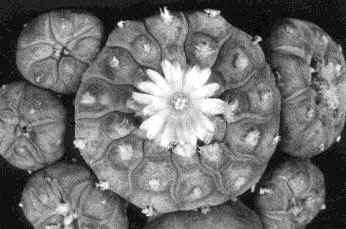PEYOTE:

DESCRIPTION:
- Peyote is a small, less than 12 cm in diameter, round, spineless cactus with fuzzy
tufts.
It rarely rises more than 2,5 cm above the soil surface. The largest part of the cactus is
its underground carrot-like root. The part that is above ground is called ďthe buttonĒ.
- Peyote is a flowering plant. The color of the flower varies from deep reddish-pink to
almost pure white.
- The fruits of Peyote develop for about a year and usually only the upper half of the
fruit contains seeds, which are black and warty.
- One medium sized individual takes about 5-15 years to nature.
CLASSIFICATION:
- Peyote cactus belongs in the family Cactaceae, in the genus Lophophora. There are 2
species of Peyote cactus. The first, commonly known peyote cactus is Lophophora
williamsii. The second one is Lophophora diffusa. I am going to talk about L.williamsii as
Peyote cactus.
- Itís also referred to as Mescal, Buttons, Big Chief and Mescalito.
DISTRIBUTION:
- Peyote grows in the southwestern United States and Mexico. Within the United States
Peyote is found in the Rio Grande region of Texas. In Mexico itís mostly found in the
Chihuahuan desert.

CHEMISTRY:
- Peyote is a hallucinogen, producing significant physical, visual and perceptual changes.
Itís used for psychedelic purposes.
- Peyote produces up to 50 chemically related compounds.
- The primary effects come from itís main active alkaloid Ė mescaline. It belongs to a
family known as phenethylamines.

- Mescaline is structurally similar to dopamine and noradrenaline. The effects are quite
similar to LSD that is often sold as mescaline.
- The amount of mescaline for a full experience is about 500 mg. The amount of Peyote
buttons to consume varies from 3 to 15.
- Peyote contains a large variety of related psychoactive compounds and thatís why
produces different and more desirable experiences than pure mescaline.
- The effects usually last for 10 hours after they begin. Peyote smtms causes disturbances
in the stomach or nausea that will pass after the first couple of hours of the high.
- The effects experienced range from a feeling of physical well being to actual visionary
experience.
HISTORY:
- The buttons are traditionally dried and eaten in a ritual setting to include visions.
- Peyote cactus has been used by natives of Mexico for thousands of years. Ritual objects
containing images of Peyote have been found dating back to 500 B.C.
- The use of Peyote as a hallucinogen was first recorded by Spanish conquistadors in the
late 15th century. Use of Peyote spread from Mexico into USA during the late 19th and
early 20th centuries. There it was and still is used by the North American Indian tribes.
CEREMONIES:
- The most simple and primitive form of peyotism is the vision quest, alone in nature.
Usually this involves fasting, solitude and quiet contemplation. The Peyote buttons are
eaten then follows a sense of physical and spiritual completion. The formalized Peyote
ceremonies contain drumming, singing, all-night prayer and stories as means of giving
thanks to the Creator.
- Peyote is smtms used as a medicine but mostly itís used to gain wisdom, achieve
specific knowledge about how to live and to gain power that is called the ally.
- There are some concerns about over-harvesting of Peyote in the wild. When properly
harvested, several new heads will form from the old root, generating new plants for the
future. Unfortunately, plants are often cut too deeply. The habitats of Peyote cactus are
also being destroyed.



